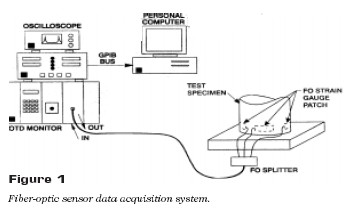The project investigated the feasibility of a fiber-optic (FO) strain sensor system for long-term monitoring of highway structures. The principle of operation relies upon measuring the timeof-flight of an optical signal’s propagation through an optical fiber and then converting it to mechanical strain. By segmenting an optical fiber string with optical reflectors, the strain of in-line segments can be determined separately. This method enables strain mapping of an entire structure with a finite-element sensor grid and is capable of detecting localized damage such as cracking and stress corrosion. The monitoring system includes a high-resolution optical time domain reflectometer (OTDR), FO data acquisition (FODAC) software, and FO strain gauge patches (FOSGPs), which allow monitoring of integral strain in large structures (Figure 1). The FOSGPs are flexible sensor patches that can be embedded in or attached to the structure to be monitored.
Tests with steel and composite coupons showed that, using the latest OTDR, the FOSGP sensors achieved a resolution of 0.01 percent strain and could resolve tensile strain in reinforced concrete just before failure due to fracture.
The sensitivity of the FOSGP sensor appears to be limited by the OTDR system. Also, the potential to multiplex patches in-line (to interrogate multiple locations) was limited because of increased attenuation of the FO sensors by the glass-reinforced epoxy carrier material. For the time delay strain measurements to be practical for structural monitoring, OTDR accuracy must be improved to at least better than 3.0 ps. The smaller 3-m patches may be multiplexed, but would require an OTDR with a resolution of better than 1.0 ps. The sensors appear to be most successful at detecting strain if placed at compression locations on concrete structures. Because of the limitations of the current OTDR system in achieving accurate measurements and the limitations of the type of optical fiber used in the concrete environment, no field demonstrations were conducted. The final report is available from the National Technical Information Service (NTIS #PB 98-139074).

The final report for this IDEA project can be found at:
https://onlinepubs.trb.org/onlinepubs/archive/studies/idea/finalreports/highway/NCHRP024_Final_Report.pdf